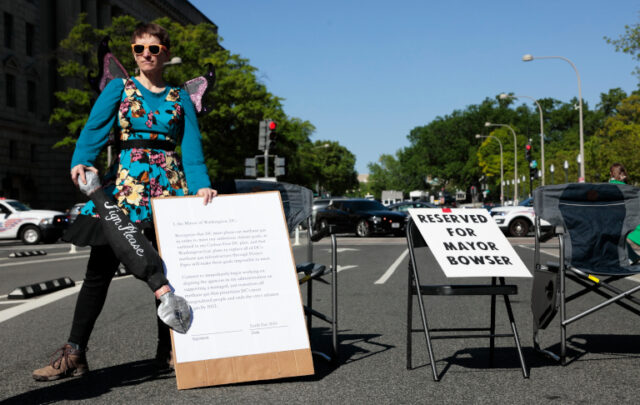On December 16 anti-pipeline activists calling themselves water protectors gathered in Rayne, Louisiana, on land located along the proposed route of the Bayou Bridge pipeline. The gathering occurred two days after the U.S. Army Corps of Engineers and the Louisiana Department of Environmental Quality granted Energy Transfer Partners (ETP) the last permit needed to build the pipeline.
The proposed pipeline would transport crude oil obtained via hydraulic fracturing (fracking) from St. Charles to St. James, Louisiana, and cross the Atchafalaya Basin, a national heritage area that is America’s largest natural swamp.
About 35 people took part in a ceremony on land that Cherri Foytlin, director of Bold Louisiana, recently bought for Louisiana Rise, an advocacy group she founded that focuses on renewable energy and a just transition. During the ceremony Foytlin requested and was granted a blessing and permission from the Atakapa-Ishak Nation to use the land that once belonged to the tribe. At the gathering the water protectors strengthened their resolve to stop the pipeline, which would be the final leg of ETP’s Dakota Access pipeline carrying oil fracked in North Dakota to Louisiana.
 Blessing ceremony over land in the proposed route of the Bayou Bridge pipeline in Rayne, Louisiana.
Blessing ceremony over land in the proposed route of the Bayou Bridge pipeline in Rayne, Louisiana.
Louisiana Governor John Bel Edwards and the U.S. Army Corps of Engineers rejected calls by a coalition of concerned citizens to conduct a full Environmental Impact Statement before granting the permit. The diverse coalition included the Louisiana Crawfish Producers Association – West and environment groups such as the Louisiana Bucket Brigade, Bold Louisiana, 350 New Orleans, Atchafalaya Basinkeeper, L’eau Est La Vie Camp, and Gulf Restoration Network.
The coalition’s common goal is to protect from further damage the Atchafalaya Basin, which is already plagued with environmental issues stemming from hundreds of pipelines that already cross the basin and thousands of abandoned wells.
Gov. Edwards and the U.S Army Corp have maintained that pipelines are the safest way to transport oil. “The Corps carefully weighed the energy benefits of the project while ensuring environmental protections remain in place,” Martin Mayer, Chief of the New Orleans District Regulatory Branch, told the Times-Picayune. “We will remain vigilant in monitoring the project to ensure that the pipeline remains in compliance with all permit conditions.”
“The expectation is that local and national markets will be served by the energy production facilitated by this pipeline,” Ricky Boyett, public affairs chief for the Army Corps’ New Orleans District, told DeSmog via email. Still, he conceded that “it is also possible that some of the product could be exported to benefit the national economy.”
“The idea that Energy Transfer Partners, which carries the designation of ‘worst spill record,’ and which has created and maintained space for human rights abuses upon peaceful people — that they would be allowed to endanger over 700 of our waterways for its own profit is not only inconceivable, but proof of a moral bankruptcy within our systems of environmental protection — but here we are,” Foytlin said in response to the granting of the pipeline’s final permit.
The groups are also trying to stop TigerSwan LLC, a controversial security firm that worked with ETP on the Dakota Access pipeline, from obtaining a permit to operate in Louisiana. TigerSwan’s permit request was denied, but the company is appealing the decision.
 Principal Chief Edward Chretien Jr giving his blessing for the land to be used by L’eau Est La Vie Camp to continue protecting the water.
Principal Chief Edward Chretien Jr giving his blessing for the land to be used by L’eau Est La Vie Camp to continue protecting the water.
 Anne Rolfes, founder of the Louisiana Bucket Brigade, being smudged with sage before the ceremony.
Anne Rolfes, founder of the Louisiana Bucket Brigade, being smudged with sage before the ceremony.
After the ceremony, I photographed Foytlin at the entrance to her property. A couple in a pickup truck pulled over and asked her what was going on. Foytlin explained that she recently bought the land to have a place for water protectors and the community to gather to continue to resist the pipeline. The couple, who live nearby on land the Bayou Bridge pipeline would also cross, warmly welcomed her, and told her they were already having trouble with ETP. They said the company is pushing back against even the smallest of requests related to issues with their land.
“Not only do we now have the blessing of the Atakapa-Ishak Nation to carry on protecting the water on this land,” Foytlin told me after the couple drove off, “but we also have a growing list of neighbors who are ready to assist in the fight to stop the pipeline.”
 Cherri Foytlin inside a structure being used to create art for pipeline resistance on the land in Rayne, Louisiana.
Cherri Foytlin inside a structure being used to create art for pipeline resistance on the land in Rayne, Louisiana.
The coalition against the pipeline is already challenging the first permit granted to ETP by the Louisiana Department of Natural Resources with a case filed by the Tulane Environmental Law Clinic, with a court date set for Jan. 4, 2018. Foytlin told me that a legal challenge to the latest permit is imminent. “We hoped the permit would be rejected but figured it wouldn’t be, so we are ready to continue to resist,” Foytlin said.
Main image: Cherri Foytlin at the entrance to her new land which the Bayou Bridge pipeline is slated to cross. Credit: Julie Dermansky





